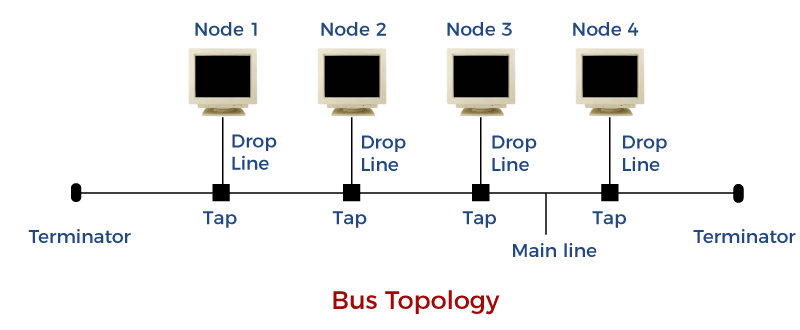Difference between the Bus topology and Ring topology
This article will discuss the differences between the bus and ring topology in detail. In the beginning, we will learn the meanings of bus and ring topology. After that, we will learn some of the differences between these two topologies.
Bus Topology:
In a Bus topology, there is a single communication line or cable shared by all the nodes in the network by drop lines and taps, as shown in the following figure:

In the above figure, the drop line connects the nodes and the mainline, using a tap to add another device to the main cable. When one computer sends a signal up the cable, all the computers on the network receive the information. Still, the message is accepted by only that computer whose address is specified in the message’s address field, and the rest of the nodes reject the message.
Ring Topology:
In-ring topology, the various nodes are connected in the form of a ring or circle in which data flows in a circle, from one station to another station. It has no beginning or endpoint that needs to be terminated in the network. The following figure shows the working of ring topology.

Some ring networks in ring topology do token passing. Every computer in the ring receives the token in sequence. Each node in a ring topology has a repeater regenerates the bits and signal in a network when a particular device receives the signal intended for another device.
Following are the comparisons between the Bus and Ring topology

| Sr. No | Basis | Bus Topology | Ring Topology |
|---|---|---|---|
| 1 | Connection of nodes | In a bus topology, all the nodes are connected to a single communication line with the help of drop lines and taps. | In a ring topology, all the nodes are connected in the form of a ring. |
| 2 | Expansion of nodes | In a bus topology, expansion is easier. A new node can be easily added using a connector. | In a ring topology, expansion is difficult. The addition of a new node disrupts the whole network. |
| 3 | Chances of data Collison | In a bus topology, the chances of data collisions are very high. | In a ring topology, the chances of data collisions are low. |
| 4 | Failure of a node | In a bus topology, the failure of a node does not affect the whole network. | Node failure breaks the ring in a ring topology, and communication stops. |
| 5 | Fault identification and Isolation | In a bus topology, fault identification and Isolation are difficult. | In a ring topology, fault identification and Isolation are relatively easy. |
| 6 | Access Rate | Sharing a single channel results in a slower access rate in a bus topology. | In a ring topology, communication delay increases with the number of nodes in a network. |
| 7 | Cabling Cost | In a bus topology, cabling cost is low as only a single cable is required to connect n nodes. | Cabling cost is very high in a ring topology as n cables are required to connect n nodes. |
| 8 | Congestion | In a bus topology, the signal send from source to broadcast, and it travels to all working stations connected to cable, so there are no chances of congestion. | In a ring topology, chances of collision is reduced because the traffic flows in only one direction. |
| 9 | Security | In a bus topology, any computer that is connected to a network will be able to see all the data transmissions on all the other computers. So there are no chances of security. | In a ring topology, the data travels from one device to another until they reach their destination, so there is a high level of security. |
| 10 | Routing Methodology | In a bus topology, when a device sends a broadcast message onto the cable that all other devices see the message, only the intended recipient accepts the message | In a ring topology, all nodes is connected to two others nodes, like points on a circle. |
| 11 | Complexity | In a bus topology, complexity is less because nodes is easy to connect or remove in a network without affecting any other nodes in a network. | In a ring topology, complexity occurs because of simple data to devices. |
